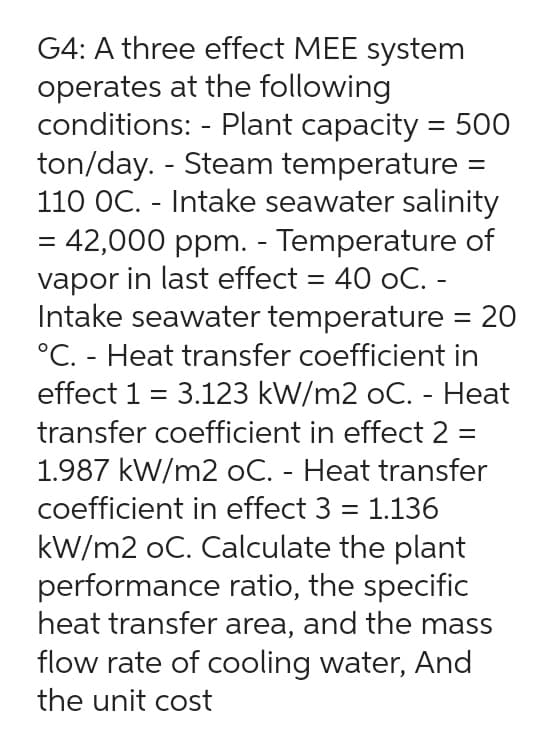G4: A three effect MEE system operates at the following conditions: - Plant capacity = 500 ton/day. - Steam temperature = 110 OC. - Intake seawater salinity = 42,000 ppm. - Temperature of vapor in last effect = 40 oC. - Intake seawater temperature = 20 °C. - Heat transfer coefficient in effect 1 = 3.123 kW/m2 oC. - Heat transfer coefficient in effect 2 = 1.987 kW/m2 oC. - Heat transfer coefficient in effect 3 = 1.136 kW/m2 oC. Calculate the plant performance ratio, the specific heat transfer area, and the mass flow rate of cooling water, And the unit cost
G4: A three effect MEE system operates at the following conditions: - Plant capacity = 500 ton/day. - Steam temperature = 110 OC. - Intake seawater salinity = 42,000 ppm. - Temperature of vapor in last effect = 40 oC. - Intake seawater temperature = 20 °C. - Heat transfer coefficient in effect 1 = 3.123 kW/m2 oC. - Heat transfer coefficient in effect 2 = 1.987 kW/m2 oC. - Heat transfer coefficient in effect 3 = 1.136 kW/m2 oC. Calculate the plant performance ratio, the specific heat transfer area, and the mass flow rate of cooling water, And the unit cost
Introduction to Chemical Engineering Thermodynamics
8th Edition
ISBN:9781259696527
Author:J.M. Smith Termodinamica en ingenieria quimica, Hendrick C Van Ness, Michael Abbott, Mark Swihart
Publisher:J.M. Smith Termodinamica en ingenieria quimica, Hendrick C Van Ness, Michael Abbott, Mark Swihart
Chapter1: Introduction
Section: Chapter Questions
Problem 1.1P
Related questions
Question
5

Transcribed Image Text:G4: A three effect MEE system
operates at the following
conditions: - Plant capacity = 500
ton/day. - Steam temperature =
110 OC. - Intake seawater salinity
= 42,000 ppm. - Temperature of
vapor in last effect = 40 oC. -
Intake seawater temperature = 20
°C. - Heat transfer coefficient in
effect 1 = 3.123 kW/m2 oC. - Heat
transfer coefficient in effect 2 =
1.987 kW/m2 oC. - Heat transfer
coefficient in effect 3 = 1.136
kW/m2 oC. Calculate the plant
performance ratio, the specific
heat transfer area, and the mass
flow rate of cooling water, And
the unit cost
Expert Solution
This question has been solved!
Explore an expertly crafted, step-by-step solution for a thorough understanding of key concepts.
Step by step
Solved in 4 steps with 3 images

Recommended textbooks for you

Introduction to Chemical Engineering Thermodynami…
Chemical Engineering
ISBN:
9781259696527
Author:
J.M. Smith Termodinamica en ingenieria quimica, Hendrick C Van Ness, Michael Abbott, Mark Swihart
Publisher:
McGraw-Hill Education

Elementary Principles of Chemical Processes, Bind…
Chemical Engineering
ISBN:
9781118431221
Author:
Richard M. Felder, Ronald W. Rousseau, Lisa G. Bullard
Publisher:
WILEY

Elements of Chemical Reaction Engineering (5th Ed…
Chemical Engineering
ISBN:
9780133887518
Author:
H. Scott Fogler
Publisher:
Prentice Hall

Introduction to Chemical Engineering Thermodynami…
Chemical Engineering
ISBN:
9781259696527
Author:
J.M. Smith Termodinamica en ingenieria quimica, Hendrick C Van Ness, Michael Abbott, Mark Swihart
Publisher:
McGraw-Hill Education

Elementary Principles of Chemical Processes, Bind…
Chemical Engineering
ISBN:
9781118431221
Author:
Richard M. Felder, Ronald W. Rousseau, Lisa G. Bullard
Publisher:
WILEY

Elements of Chemical Reaction Engineering (5th Ed…
Chemical Engineering
ISBN:
9780133887518
Author:
H. Scott Fogler
Publisher:
Prentice Hall


Industrial Plastics: Theory and Applications
Chemical Engineering
ISBN:
9781285061238
Author:
Lokensgard, Erik
Publisher:
Delmar Cengage Learning

Unit Operations of Chemical Engineering
Chemical Engineering
ISBN:
9780072848236
Author:
Warren McCabe, Julian C. Smith, Peter Harriott
Publisher:
McGraw-Hill Companies, The